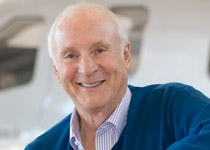Magellan wouldn't believe it
Flying from here to there these days is easy
I had made a short announcement on the PA to inform our passengers that we had just passed the midpoint of our journey and would be landing in Honolulu at 9:05 p.m.
Moments later there was a coded sequence of knocks on the cockpit door. A flight attendant entered and handed me a note from a passenger who undoubtedly was upset that I had interrupted his movie. I unfolded the note, which asked, “Why are we off course?”
I passed the note to my first officer. “Some character in 4-B,” I said with a chuckle. Our three inertial navigation systems agreed that we were on course. We were also directly below and in line with Air New Zealand’s contrails. It was like following a railroad track and confirmed that we were tracking precisely along the airway.
I later left the flight deck for a cabin tour—which was legal in those days—but before returning I headed for passenger 4-B. The man seated there was busily involved with a then-new handheld GPS receiver, which could determine aircraft position to within a few feet. He saw me approaching and extended his right hand. “Hi, Barry. I’m Ed King.” The avionics pioneer apparently did know our position more accurately than we did. This was when I began to realize that the art and science of navigation was coming to an end. GPS receivers would soon become as commonplace as four-function calculators.
When I began flying in the early 1950s, the VOR was just being introduced and many pilots still used Morse code to “follow the beam.” An A (dot-dash) meant you were on one side of a beam and hearing an N (dash-dot) meant you were on the other. A steady tone between the A and the N meant you were on course. Increasing volume meant you were getting closer to the low-frequency range station, and vice-versa.
Years of wearing medieval “skull crushers”—there were no comfy headsets in those days—and enduring static-filled frequencies explained why hearing loss was an occupational hazard.
Green, Red, Blue, and Amber airways preceded Victor airways, and progress along them was determined by noting the identifiers of marker beacons located along the way. A marker identified by three dots and two dashes, for example, meant that a pilot was passing the third marker on the second leg (beam) of a four-course range.
At night, pilots could navigate along an airway by flying from one airway beacon to the next. These rotating beacons were placed about every 10 miles along an airway and flashed a Morse code letter so that a pilot could determine his progress. The beacons were lettered W U V H R K D B G and M. This sequence was repeated every 100 miles and was remembered by learning the mnemonic “When Undertaking Very Hard Routes Keep Directions By Good Methods.”
My instrument flight training was divided equally between a Link trainer and a Stinson Voyager. This was before an artificial horizon and a directional gyro were required for IFR flight. We flew using “needle, ball, and airspeed.” This was also before the advent of the personal hood. Prior to a training flight, the instructor would cover the insides of our cockpit windows with pre-shaped panes of orange plexiglass. The student would then don a pair of blue goggles and the world outside his cockpit would suddenly become pitch black. Cheating was impossible.
Navigation was challenging. Pilots even got lost on occasion, which is virtually impossible using GPS. Flying from here to there these days is as easy as dialing a telephone number and waiting for distance to count down to zero.
Some pilots no longer refer to charts to see where they are. They’re concerned only with where they’re going. Others use GPS to concoct and execute home-brewed IFR approaches to VFR-only airports, which proves that complacency does indeed breed contempt.
Some things in the ’50s were easier. Airspace restrictions were the exception rather than the rule, and regulations were so few that a pamphlet contained all that a pilot needed to know. One regulatory quirk caught my eye in 1956 and prompted me to waltz into an FAA office and request a balloon rating. The inspector was dumbfounded to learn that there were no requirements for the certificate. It was free for the asking by any pilot with a current medical.
Word got out and demand for the rating inflated. The FAA acted quickly to close that regulatory loophole. This explains how I obtained my balloon rating without ever having been in one. And that’s not hot air.
Barry Schiff has been writing "Proficient Pilot" for almost 33 years.



